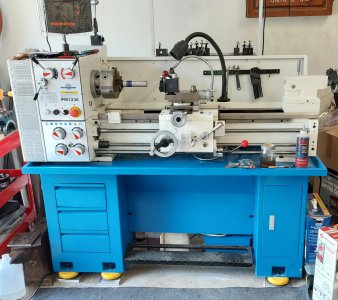Pevehouse, I feel your pain. If that frame was installed without the bed being level then it is a contributing factor. When I received my PM1236 (new) through its travels and being mounted to a wood pallet, the bed was warped and it took me 3 or 4 months worth of patients to get it out because the bed needs to settle. Mine is mounted on the cabinet it came with and I have the leveling feet under that which I bought with the lathe. I wasn't making good progress until I put 150 pounds of lead in the cabinet on the corner that needed to drop. I then leveled it as best I could and backed the pressure off the corner with the lead in it ever so slightly to allow it to drop. After 2 or three weeks I put the level on it and adjusted it again in the same manner (rinse lather repeat) Once I had it level I adjusted the feet until the day I placed the level on it and it had not changed from the previous adjustment, it had reached equilibrium. I had a few tapered parts until it was level, into each life a little rain must fall; but now it cuts true.




